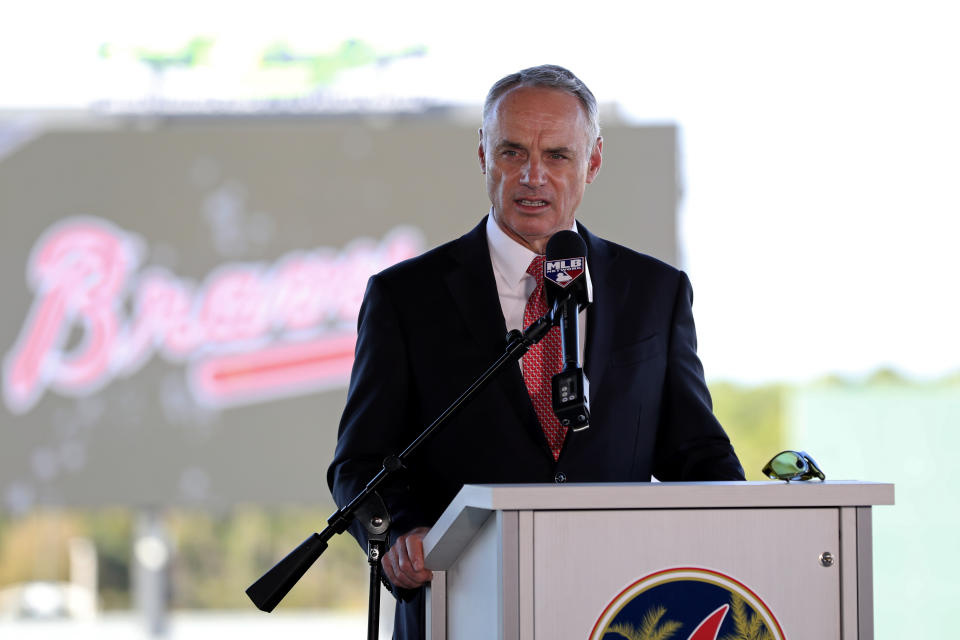Then what? Even if contained, coronavirus creates uncomfortable scenarios for MLB
Out across the empty diamonds and grocery shelves, beyond the shuttered stadiums and pubs, on the other side of anxieties quiet and full blown, lies the decision of when to play baseball again.
If, maybe, to play again.
When to open doors closed and latched and sealed with bath towels to protect us from ourselves. When recovery and normalcy can be rediscovered, then believed. If that day, when it comes, really is today or tomorrow or not at all for another while, and who can be trusted to make that call.
And, then, how to play again.
This week, Major League Baseball commissioner Rob Manfred announced the league would adhere to Centers for Disease Control and Prevention recommendations to ban crowds of 50 or more people for at least the next eight weeks to help stop the spread of the coronavirus. The season, then, would be delayed six weeks, at minimum, into the middle of May. Into that vortex disappeared Manfred’s prior announcement, from four days before, that the baseball season would be suspended for two weeks. Normal life awaits the next vortex.
From their Rockefeller Center headquarters, and now primarily in their dens and on their living room couches that pass as their headquarters and otherwise in their de facto Jupiter, Florida, headquarters, MLB decision-makers operate within the whims of the pandemic. Plans for tomorrow, next week, next month, this summer, no matter how considered and well-intentioned, are long jump shots in the wind.
Into a public confined and yearning for distraction, for its baseball high, Manfred and company lean, measuring that jumper. Same as the NBA, as the NHL. Soon, perhaps, the NFL. Professional baseball leagues in Japan and Korea indefinitely delayed their seasons, as well.
One day routine will return to all of the places that breathe life into the routine. Music will fill the clubs again, beer will pour from the taps, and in the place where the corner of the room meets the ceiling a West Coast ballgame will light the conversations.

Until then, getting from here to there is the slog of slow time, of screaming headlines, of reliable routines, even as those routines get narrower and narrower. What comes is to wonder about the spin rate of a flattened curve. What is to be believed?
The baseball season, if there is one, will not be 162 games. The details beyond that decidedly vague observation are equally elusive.
For example, assume there is a hopeful break in the pandemic as the nation inches toward May or June and that every big-league city gets there at about the same time, and it begins to appear there can be small or even large gatherings again, which means there could be baseball again. Clubhouses, remember, hold small gatherings. Assume there are shortened spring trainings and lengthened rosters and MLB and the players’ union have agreed on the details of who gets paid, who gets service time, who shares what. Assume everything doesn’t actually look worse in two months.
Everything, today, is assumptions.
So, the season begins. Stadiums in safer cities go back into business. They play games for three weeks. Summer breezes carry familiar sounds and scents. The game feels rushed and clumsy but that’s OK, it’s still the game. It still fills our souls. That’ll do.
Then an outfielder in, say, Chicago tests positive for the virus, which means an entire clubhouse is vulnerable, which means every team that team played is vulnerable, along with every person with whom that outfielder has come into contact in the 21 hours per day around the games.
Is there room for Then what? Can a team or two or three quarantine for two weeks while the rest of the league plays? Will the landscape change enough by then?
League and team officials are not close to knowing what the world will look like in a month or two or three. Nor should they be. First, they are baseball people. They’re fighting with the union over service time and trying to take care of the guy who hawks snow cones and everything in between. Second, they’re in this with the rest of us, home-schooling 10-year-olds and wondering when fourth-grade math got so tough, gauging entry into the dairy aisle like it’s a double-dutch contest, staring out windows and wondering how we got here and, more, how we’ll get out of it.
Meantime, when MLB officials recently entered the St. Louis Cardinals’ facility, they were permitted to pass only after their temperatures were checked.
The season will start when experts, scientists, medical professionals and anyone else who is reasonably bright give the all clear. That, right now, is the plan. That, and to inch closer to that way out, to build possible solutions upon possible solutions — scheduling, rosters, protections, various Whack-A-Mole issues — and to root for the men and women who’ll fix us up and send us back out into the world. There’s a vision out there that includes baseball, all sports, all the usual stuff, and that maybe also includes a medical breakthrough and a new normal of daily temperature checks at the door of every clubhouse and a method of on-site testing to reassure them. And us.
The hypotheticals are hard and exhausting enough without seeking to peer out over an entire summer. Until then, Manfred wakes up every day to a sideways world in which people stay home and don’t watch baseball, because there is no baseball, and soothes himself with the knowledge that it is temporary. How temporary, exactly, will be his call, with a lot of help. For the moment, the wind is blowing. And the jumpers aren’t falling.
More from Yahoo Sports:

 Yahoo Finance
Yahoo Finance 

